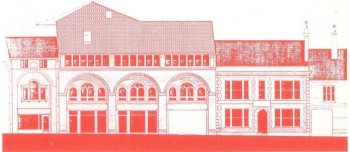Jewry Street
East Side to High Street

This side of Jewry Street has a number of listed building of Group value Grade II including No. 29a and Nos. 34-37, 38 and 39.
Century House (Nos. 30/31) designed by T D Atkinson in 1925, is a copy book example of Classical detail. In the same year the Gothic Roman Catholic Cathedral Church was built in what had been the gardens of No. 29.
This part of the street merits a face lift and the removal of intrusive shop signs.
The drawing below includes the rebuilt part of the old theatre (page 11) and the replacement building (1982) of shops and offices, costing £850,000, by architects Evans Roberts and Partners.


The drawing to the right is of the only purpose built theatre in Winchester, constructed at a cost of £1,000 from private subscribers.
The owners, Harris and Collins, opened with Sheridan's play The Rivals in 1785. These two had built up a theatre circuit between Salisbury, Southampton and Chichester.
The players visited Winchester in July during Saint Swithuntide, coinciding with horse racing at Worthy Down, dancing in St John's Assembly Rooms and cock fighting in the city taverns.
The audience sat on back-less benches in the pit and the gallery, with boxes higher up. Prices were three shillings for box seats, two shillings in the pit and one shilling in the gallery.
The theatre could not pay its way so in 1861 it was auctioned and later gutted. The building for H W Framptons (photo below) was designed by the son of H W F in the fashionable Classic, including Greek style ornament. This business failed in 1912. The firm had been in the Corn Exchange since the 1860s.


The George Inn had been on the site of the present Barclays Bank since the 1400s, with the main entrance in High Street.
At one time it was called the New Inn, later the Moon Hotel and in the 15th century was acquired by the city at a figure of twenty pence ground rent. It was largely rebuilt in 1769, being then in private ownership. Before 1939 the hotel was bought by the Ministry of Transport and leased to the Agriculture Ministry during the war as HQ for Hampshire's Agricultural Executive Committee. It was also used by some of the Bank of England staff evacuated from London.
The hotel ran a horse drawn-carriage service to meet all trains when the railway station (architect Sir William Tite) was completed in 1838.

Barclays Bank by W Curtis Green, architect, opened in 1959. Sir Nikolaus Pevsner comments "it makes this building rather impertinent in comparison with the old guildhall (now Lloyds bank) in the High Street. It must be one of the last historicist buildings in England".
